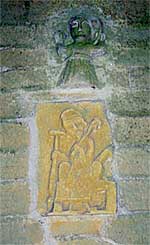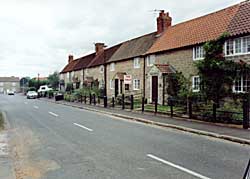 Small Norman figures over the south door of
the church (A
Nicholson, 2003).
Small Norman figures over the south door of
the church (A
Nicholson, 2003).Just within the Church door is a stone with a richly foliated incised cross, and though mutilated, three of the live crosslets, which represent the wounds of our Saviour, remain These altar-stones, as they are sometimes called, are rare; a perfect one is in existence at Brightingsea Church near Colchester. The three incised slabs, on which no date has been found, are very correctly depicted by the Rev. Edward Cutts in his Manual of Sepulchral Slabs and Crosses. In the porch are several ancient stones, one over the door, of Saxon date, is engraved in Thoroton. Two, apparently of the same era, are built into the wall on each side the doorway, and two others nearer the entrance, of later date, bear the insignia of a blacksmith. Many other sepulchral slabs with elegantly incised crosses remain within and around the Church, making us regret the want of reverence and absence of good taste which have defaced and despoiled so many of our ancient Churches.
The Church-yard contains a splendid yew tree, probably a memorial of the time when it was ordered that a yew tree should bo planted in every Church-yard, to secure a supply of wood for the tough yew bow, which made English archers so famous. The girth of this tree is fourteen feet, and its branches extend in a well defined circle of nearly sixty yards. The stem is hollow and a young sapling has sprung- up in the cavity.
Amongst the old tombstones in the Church-yard one bears date 1627: the name is obliterated, but the same bell must have pealed forth the same invitation to him as it now repeats to us. Another of the date 1666 shews where one was laid to rest in this quiet "God's acre" at the time when London was desolated by its great fire, of winch perhaps no tidings had reached that distant village. An iron railing encloses the burying place of the Right Honourable Frederick Montague (date 1800), who had expressed his desire to be laid in the Church-yard among his tenantry and the old servants of his family. A tombstone in the Church-yard dated 1828 has the following quaint epitaph : —
"Life's but a cob-web,
Be we e'er so gay,
And death's the broom
That sweep's us all away."
The ancient font, discarded when the Church was modernized, still remains here, moss-grown and almost unnoticed, but it is hoped this relic will shortly be replaced in its proper position.
Papplewick was a perpetual curacy but is now annexed to the Rectory of Linby, in the gift of Mr. Montague. Its history seerns to be as follows. The ancient Church of Papplewick, which was probably Saxon, existed when the monastery and priory of Newstead were founded by Henry II. about 1170, part of the endowment of the latter being lands in Papplewick previously obtained by the king from the monks of Lenton in exchange for other land. " He also gave," says Thoroton, "the town of Papulwick with the Church of the same and the mill to the canons of Newstede of the order of St. Augustine. He also gave them the Abbey field, lying between the town of Papilwyke and the said monastery, upon the head of which the canons made a Grange nigh the town." The farm still bears the name of Newstead Grange.
The services of the Church appear to have been performed by one of the monks from Newstead, until the dissolution of the monasteries by Henry the 8th. The deed by which Newstead and Papilwick were bestowed upon Sir John Byron is extremely interesting. It states that in consideration of the good, true, and faithful service of the knight, and also of the sum of £810 of the lawful money of England paid "by him into the hands of our Treasurer" the King gave and granted to him the site and foundation of the late Monastery of Newstead within the Forest of Sherwood. In the appurtenances of the Priory are included the dove-cots, pools, kitchen gardens, and vivaries—doubtless rabbit warrens, for which Newstead is still celebrated. It describes the names and acreage of every field, and with those in Paplewyke the names of the previous tenants are given. The benefice of the Parish Church of Aplewick with its rights and appurtenances, tithes and emoluments, advowson and patronage are conveyed to Sir John Byron and his heirs, who were required to provide a Chaplain for Papilwick Parish Church, with the cure of souls, his stipend being £2 13s 4d.
From that time the stipend of the minister of Papplewick was paid by the possessor of the estate, and in 1709 Sir Theodore Colladen, then the owner, writes thus:— "Sir, We have received a petition under the hands of several of our tenants to allow something above the five pounds that have been usually paid by us to the minister of Paplewigg and are willing so farr to comply with their desire as to allow the present incumbent, Mr. Mince, three pounds per annum over and above the said five pounds, as we did to his predecessor, and to continue this only so long as we shall think fit. Witness our hands THEODORE COLLADOM, JOHN WICKART." The letter is dated "Windsor," where Sir Theodore, who was then Physician to Queen Anne, was probably staying, and is addressed thus. "These for Mr. Samiwell Low at the Unicorn, Nottingham."
The curacy of Papplewick has gradually been augmented by the bounty of the patrons and gifts from Queen Anne's Bounty. It is now rather under £100 per annum, and after having been long a dependancy of Newstead, it is in fact its Parish, as a marble cross marks the spot where the infant son of Mr. Webb, the present possessor of Newstead, was laid to rest in Papplewick Churchyard.

Stone Cottages on Main Street, Papplewick (A Nicholson, 2003).
Doomsday Book mentions in Papplewick some of the "land of the Taynes which Alfric, and Alfa, and Elric had," and paid the Dane gelt for 2 carucats 3 bovats, appoximating 300 acres by modern measurement, but they were then waste. The parish now contains about 1850 acres, and is in posession of Andrew Montagu, Esq. A portion consisted of bog, moor, and open forest, but about 35 years ago, the bog was drained, and the forest land enclosed. This effected great changes. Papplewick had been famous for its breed of forest sheep, and an annual fair was held in September at which they were in great request, but the short turf changed into arable land, was no longer available for their pasture, the supply of forest mutton declined, and the fair ceased to be held. At one time the estate was noted for its great variety of game, but as bog, moor, and open forest disappeared, the snipes, woodcock, grouse, and blackcock which occasionally visited it are no longer found.
The wild flowers of the neighbourhood were the resort of many rare and beautiful butterflies, but they departed with the peculiar weeds on which they fed, and after the drainage the bog plants vanished, as well as the glow-worms which used to spangle the roadside banks on warm summer nights. But if the man be a benefactor to his race who makes two blades of grass grow where only one grew before, the change of forest, moor and bog, into well-cultivated land must be a benefit, not only to the present but also to succeeding generations.
The river Leen, or Lyn, runs through the parish from north to south. For sixty years its stream was utilized as the motive power for several cotton mills erected by Mr. Robinson under lease. Seventy acres were occupied as reservoirs and watercourses, and one of the largest wheels in England revolved in fearful majesty. It was a breast wheel of 44 feet in diameter. The late Duke of Sussex, when visiting Colonel Wildman, came to see this wheel in 1826. The mills had been successfully worked, but, by degrees Lancashire became the centre of the cotton manufacture, the facilities of steam superseded the cumbrous requirements of water-power, and after the expiration of the leases in 1840 the mills were taken down, the watercourses gradually filled up, and Papplewick returned to its ancient condition of an agricultural village.
MRS. RILEY, Papplewick.
